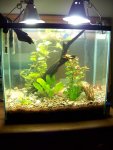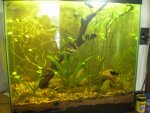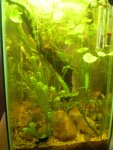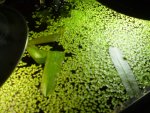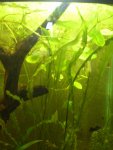pondkid
New member
Several months ago, I was looking to renovate my small planted tropical fish tank (U.S. 16 gal) and I came across an interesting method of maintaining a healthy, naturalistic, sustainable aquarium. It involves using plain potting soil as the majority of the substrate. I know that this isn't a tropical fish forum, but I don't see why the method I used wouldn't work for aquatic caudates. Later this summer I plan on setting up a newt enclosure using this same technique. I'll let y'all know how it goes.
First off, I put about 2 inches (maybe a little less) of organic potting soil I got from Wal-Mart in the bottom of the aquarium. You could even use dirt from your garden, but only if you do not use inorganic fertilizers and pesticides/herbicides. Over this I laid a layer (about 1.5 inches) of puffed clay and pea gravel. The puffed clay was more of an experiment. Its intended use is for potting aquatic plants for garden ponds. I got it at a local garden center. If you don't have it available, plain pea gravel works just fine. The whole purpose of the gravel is to hold the soil in place.
At this point I planted the plants, arranged the piece of wood, and added some larger decorative rocks. Note: there is no water in the aquarium yet. Make sure the roots of your plants extend into the soil layer.
Very slowly add water and take care to not disturb the soil layer. The water should be relatively clear if done correctly.
Lighting: I used two full spectrum, screw-in fluorescent bulbs in two small clamp lamps. The bulbs are 26 watts each. It is very important to use the full spectrum bulbs! Otherwise, your plants will dwindle away. Check the color temperature on the package. It should be 6500K (standard light bulbs are about 2700). I got my bulbs at Menard's for about $5 each. I have them on a timer (12 hours on and 12 off).
Filtration...well, this is the catch...there is no filter! I have a small pump to circulate the water, but no filtration is necessary. The live plants and naturally present bacteria are the true filter. My aquarium has been set-up for about 4 months now, and I have yet to change water, clean it (except for occasionally scrubbing the algae off the glass), or vacuum it. I just add water periodically.
Some things to keep in mind:
Lots of plants are needed to make this work. Mine grow like crazy. I have to cut hand fulls of pond weed out of my aquarium on a regular basis. All the plants use up the nutrients in the water and prevent an algae bloom.
During the first month or two, your aquarium will look really ugly. This is a living biological system, and it requires time to balance out. Algae will take over and your water will get cloudy and a little murky sometimes. Do not worry. This will all go away. Having some good algae eating fish helps. I used 2 Siamese algae eaters and 2 octocinclus catfish.
Once this is set-up, do not do anything to disturb the soil. There are lots of bacteria breaking down the wastes of the animals and the organic matter in the soil. They are good in the soil, but they could be toxic if released into the water column.
Pictures
The first picture is what the aquarium looked like the day I set it up. Some of the plants really took off, and others did not work out so well.
The next pictures are of what the aquarium looks like today. I recently cut out a lot of the plants, but I'm sure they will be back. There is also duckweed growing thickly on the surface. I have to net it out when it becomes too thick. Some of the plants have grown to the surface and bloomed above the water (sorry I don't have any flower pictures).
As you can see, I haven't really aquascaped the aquarium. I pretty much left it to its own devices. This give the aquarium a much more natural and wild feeling (at least I think so). Kind of like a chunk out of a tropical pond.
So that's it. I just thought those of you who like naturalistic set-ups might be interested. This method was originally thought up by Diana Walstad. She is an aquatic plant ecologist and wrote a book all about this (Ecology of the Planted Aquarium). I didn't follow her method exactly, but her method was the major inspiration.
Let me know what you think.
First off, I put about 2 inches (maybe a little less) of organic potting soil I got from Wal-Mart in the bottom of the aquarium. You could even use dirt from your garden, but only if you do not use inorganic fertilizers and pesticides/herbicides. Over this I laid a layer (about 1.5 inches) of puffed clay and pea gravel. The puffed clay was more of an experiment. Its intended use is for potting aquatic plants for garden ponds. I got it at a local garden center. If you don't have it available, plain pea gravel works just fine. The whole purpose of the gravel is to hold the soil in place.
At this point I planted the plants, arranged the piece of wood, and added some larger decorative rocks. Note: there is no water in the aquarium yet. Make sure the roots of your plants extend into the soil layer.
Very slowly add water and take care to not disturb the soil layer. The water should be relatively clear if done correctly.
Lighting: I used two full spectrum, screw-in fluorescent bulbs in two small clamp lamps. The bulbs are 26 watts each. It is very important to use the full spectrum bulbs! Otherwise, your plants will dwindle away. Check the color temperature on the package. It should be 6500K (standard light bulbs are about 2700). I got my bulbs at Menard's for about $5 each. I have them on a timer (12 hours on and 12 off).
Filtration...well, this is the catch...there is no filter! I have a small pump to circulate the water, but no filtration is necessary. The live plants and naturally present bacteria are the true filter. My aquarium has been set-up for about 4 months now, and I have yet to change water, clean it (except for occasionally scrubbing the algae off the glass), or vacuum it. I just add water periodically.
Some things to keep in mind:
Lots of plants are needed to make this work. Mine grow like crazy. I have to cut hand fulls of pond weed out of my aquarium on a regular basis. All the plants use up the nutrients in the water and prevent an algae bloom.
During the first month or two, your aquarium will look really ugly. This is a living biological system, and it requires time to balance out. Algae will take over and your water will get cloudy and a little murky sometimes. Do not worry. This will all go away. Having some good algae eating fish helps. I used 2 Siamese algae eaters and 2 octocinclus catfish.
Once this is set-up, do not do anything to disturb the soil. There are lots of bacteria breaking down the wastes of the animals and the organic matter in the soil. They are good in the soil, but they could be toxic if released into the water column.
Pictures
The first picture is what the aquarium looked like the day I set it up. Some of the plants really took off, and others did not work out so well.
The next pictures are of what the aquarium looks like today. I recently cut out a lot of the plants, but I'm sure they will be back. There is also duckweed growing thickly on the surface. I have to net it out when it becomes too thick. Some of the plants have grown to the surface and bloomed above the water (sorry I don't have any flower pictures).
As you can see, I haven't really aquascaped the aquarium. I pretty much left it to its own devices. This give the aquarium a much more natural and wild feeling (at least I think so). Kind of like a chunk out of a tropical pond.
So that's it. I just thought those of you who like naturalistic set-ups might be interested. This method was originally thought up by Diana Walstad. She is an aquatic plant ecologist and wrote a book all about this (Ecology of the Planted Aquarium). I didn't follow her method exactly, but her method was the major inspiration.
Let me know what you think.

